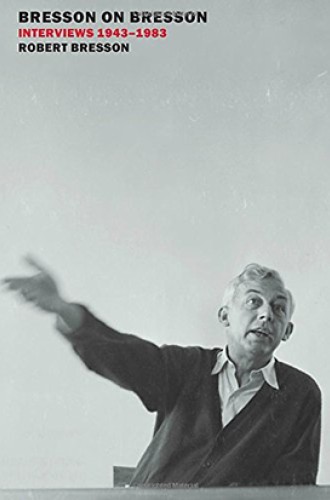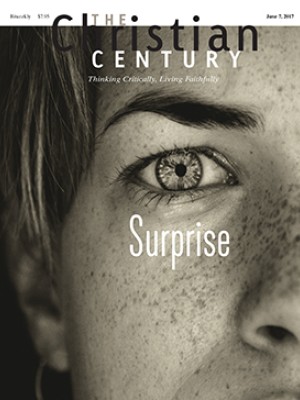Improvising the music of daily life
Robert Bresson’s films are adventurous, brooding, and deeply religious.
This collection of interviews with the great French filmmaker Robert Bresson contains much for anyone interested in film or faith. Bresson, who died in 1999 at the age of 98, was one of the most important (if not most influential) directors of the last century. Born, raised, and educated a nominal Catholic near Paris, he began his career as a painter and photographer, immersed in the arts scene. During World War II, he spent a year in a Nazi prisoner-of-war camp. After the war, he turned to making films.
Bresson became famous for his techniques. While filming his first picture, he noticed that the actors he’d cast “suddenly ceased to be people” while acting. Henceforward, he hired men and women “who didn’t act”—who were amateurs, or, as he preferred to call them, “models.” He wanted them to know almost nothing about a film before shooting began, and once it began he wanted them to remain themselves rather than attempt to embody a character.
Read our latest issue or browse back issues.
Bresson’s films revolved around sin, shame, passion, and redemption. These themes were embodied in characters that included a depressed provincial pastor, taken from a Georges Bernanos novel, the misunderstood saint Joan of Arc, and a man struggling against evil, pulled from a short story by Tolstoy. Balthazar, at Random (1966) tells the story of a donkey, as inspired by Dostoevsky’s The Idiot. (You can watch the amazing two and a half minute final scene online.)
Despite critical accolades and a devoted if small following, Bresson experienced persistent difficulty when seeking funding for new projects. (Imagine those pitch meetings!) He was always consciously trying to make cinema an art form.
When I first watched The Angels of Sin (1943), Diary of a Country Priest (1951), and The Trial of Joan of Arc (1962), I remember being arrested by the close-ups of concentrating, unadorned faces. Recently I loaned my copy of The Trial of Joan of Arc to an atheist friend who, when she returned it a week later, said that she’d wept while watching it. Bresson’s spare, honest approach elicits raw emotions. “It’s the knots that tie and unravel inside the characters that give a film its movement,” he said in a 1946 interview. He developed characters from the inside out.
Bresson downplayed the role of a script, preferring to improvise while filming. He was, after all (and as he often reminded interviewers), a painter first and foremost, not a writer. He also downplayed the purpose of a soundtrack in order to focus instead on what he called “the music of daily life.”
Most of all, he sought to draw out interiority—which isn’t easy to do on film. On choosing Bernanos’s novel Diary of a Country Priest for adaptation, he said,
What drew me to this book above anything else was the interiority of the plot and dramatic threads. . . . I believe that the action in film must become—will become—more and more interior. . . . [W]hat we have understood so far as . . . the kind of motion, or movement, we currently seek in films, is nothing more than restlessness.
To my eyes and ears, Bresson’s films are deeply religious, although he does not speak of them in such terms in these interviews. When he talks of “luck” and “truth” as his method and purpose, I hear a man schooled in faith and perhaps even listening to the Holy Spirit. There may be no other way to explain an artist who prepares for his work like this: “I make a point of forgetting, the night before a shoot, what I’m going to do in the morning so that I’ll have a very strong feeling of spontaneity.”
But if this is religious instruction, it is in the postmodern mode. For example, Bresson asked his models (not actors) to “learn their lines not as a text that has meaning but like something that makes no sense at all, like a sequence of syllables. . . . I ask that the meaning come from them, from their own impulse, in the moment when . . . I let them loose in the world of the film.”
When Bresson talked about Bresson—which he did a lot, over a long career—he did often speak about spiritual matters. In an interview from 1973 that’s not included in this book, Bresson quotes Milton’s Paradise Lost to explain why he doesn’t crowd films with music and other diversions: “Silence was pleas’d.” He further explains, “I try to catch and to convey the idea that we have a soul and that the soul is in contact with God. That’s the first thing I want to get in my films—that we are living souls” (see The Films of Robert Bresson: A Casebook, by Bert Cardullo).
Many of the interviewers comment on Bresson’s bright, joyful appearance—his blue-green eyes that light up, the smile that flashes on his face, and an open expression and attitude toward life. He was, indeed, a man full of life on the outside. Yet his films were full of brooding. Bresson was a paradox. One of his interlocutors says it best, near the end of this book: “What matters to you [Bresson] is what can’t be seen.”






